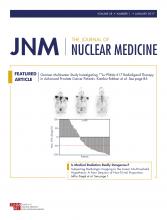REPLY: We thank Dr. Gravel and colleagues for their comments on our study, which showed the superiority of 68Ga-DOTATATE PET/CT over other imaging modalities in the evaluation of head and neck paragangliomas (HNPGLs) (1). Specifically, they comment that the use of MRI within the study is suboptimal because of the lack of contrast-enhanced angio-MRI (CE-MRA) covering the head and neck area. First, we would like to emphasize that 68Ga-DOTATATE PET/CT is particularly adapted to the exploration of HNPGLs because of the highly elevated uptake values within these tumors, with an excellent and uniquely favorable signal-to-background ratio. This pattern enables easy detection of millimeter-sized tumors, which, unlike in MRI, is less dependent on operator experience. This notion is shared by most practitioners who work in high-volume hospitals in which this modality is available. It is true that the angio-MR sequences are sensitive and that whole-body MRI can be applied to these patients. However, in our paper, we assessed sensitivity—not specificity—in the detection of HNPGLs. Furthermore, in their letter, the authors cite references supporting the comparable sensitivity of CE-MRA and conventional MRI (2). Therefore, their claim that we did not use a state-of-the-art imaging method is not convincing. We would also like to point out that the original Eunice Kennedy Shriver NICHD protocol 00-CH-0093 was approved to perform this study using conventional MRI in the evaluation of HNPGLs in comparison to other imaging modalities, as stated in our paper. Any deviation from this protocol after study commencement several years ago would be scientific error. It is not scientifically sound to add new imaging modalities to an ongoing study when a new imaging modality and its application to a particular cancer appears in the literature (2). The same criticism could apply to a study cited by the authors (3) in which 111In-pentetreotide (Octreoscan; Mallinckrodt/Covidien) was used despite the fact that 68Ga-DOTATATE PET was already on the horizon and was suggested to be a promising agent for primary and metastatic paragangliomas, including those of the head and neck (4,5).
The lack of MRA sequences in our study is a limitation that we underlined in our discussion of the study. Thus, we invite the authors to refer to this section of the published paper. From a perspective standpoint, we would prefer to start with a highly sensitive PET evaluation using 68Ga-DOTATATE, which enables the detection of all body sites, and to then follow with anatomic imaging. The systematic initial use of whole-body MRI appears time-consuming, less informative than targeted strategies with highly sensitive sequences, expensive, and not cost-effective. Furthermore, the U.S. Endocrine Society clinical practice guideline related to pheochromocytoma and paraganglioma does not suggest whole-body MRI in these patients, unlike the erroneous suggestion of Gravel and colleagues (who even include a member of the expert panel that produced this practice guideline). We also doubt that (at least in the United States) insurance companies will cover whole-body MRI, particularly in patients with HNPGLs. Exceptions may occur if an HNPGL is discovered to be hereditary, but without appropriate biochemical evidence this can be an obstacle and is therefore unrealistic. Rather, this strategy should be proposed in each institution depending on the practical situation, the experience of the institution, and additional findings related to biochemical and genetic analysis of PGLs. We agree that CE-MRA is a good method for studying paraganglioma tumors, but its role may be more important in further evaluation of a specific tumor identified by whole-body 68Ga-DOTATATE PET/CT and in surgical planning.
Footnotes
Published online Aug. 4, 2016.
- © 2017 by the Society of Nuclear Medicine and Molecular Imaging.







